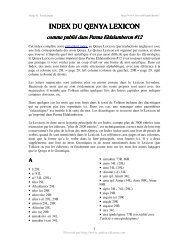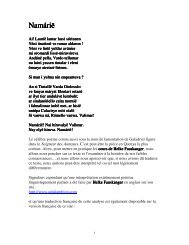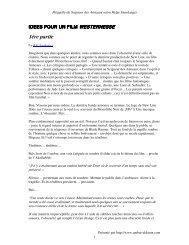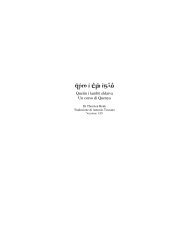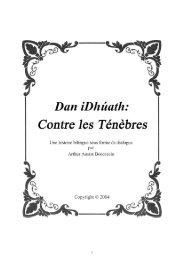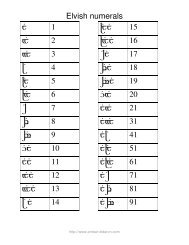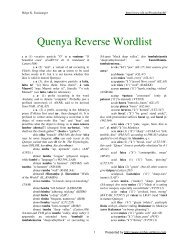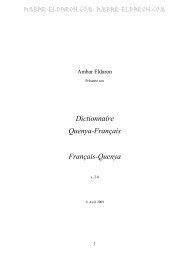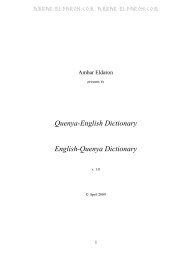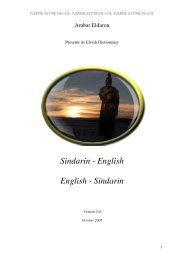Bilingual version Quenya - English - Ambar Eldaron
Bilingual version Quenya - English - Ambar Eldaron
Bilingual version Quenya - English - Ambar Eldaron
Create successful ePaper yourself
Turn your PDF publications into a flip-book with our unique Google optimized e-Paper software.
Concerning Copyright and Other Matters<br />
Some of the persons and locations in the following story are loosely based on persons<br />
and locations described in Tolkien’s works. This is for the purpose of atmosphere only and is<br />
not intended as a reinterpretation of Tolkien’s works.<br />
This story was originally written for the author’s personal amusement as an attempt to<br />
better understand the <strong>Quenya</strong> language in all its beauty and complexity, but it is essentially a<br />
neo-<strong>Quenya</strong> text. The grammatical structure, syntax and vocabulary are mostly based on<br />
Thorsten Renk’s Quetin i lambë eldaiva, and Helge Fauskanger’s <strong>Quenya</strong> Course. Any<br />
divergence from this is based on my own interpretation of the language. Reconstructed words<br />
either from Sindarin or Common Eldarin not found in the usual wordlists are so noted.<br />
For those who find neo-<strong>Quenya</strong> untenable, may I respectfully suggest you treat the<br />
language of the text as dialectical, since it is attested that there were dialectial differences<br />
between the three groups of Elves living in Valinor. And while <strong>Quenya</strong> was never spoken in<br />
Númenor as an everyday language, for purposes of this story, this is the language of choice<br />
among the various characters.<br />
Due to the complexity of, and even uncertainty about, the <strong>Quenya</strong> pronomial system,<br />
certain editorial decisions were made. Thus, for purposes of this story, the following holds<br />
true:<br />
The second person pronomial endings are:<br />
-tyë/-t: familiar singular -ccë/-l: familiar plural<br />
-lyë/-l: polite singular -llë/-l: polite plural<br />
The third person singular pronomial endings are –ryë/-s for all genders.<br />
The first person plural pronomial endings, based on Thorsten Renk’s reasoning, are:<br />
Exclusive We: -mmë/-m Inclusive We: -lmë/-m<br />
Dual We: -lvë/-m<br />
The independent first person plural subject pronoun remains me for both the Inclusive<br />
and Exclusive forms and met for the Dual, while the Accusative/Dative forms are me/men,<br />
respectively for both the Inclusive and Exclusive forms. The Dual Accusative/Dative forms<br />
are met/ment, respectively.<br />
My thanks to Helge Fauskanger and Evenstar for their assistance in this project,<br />
and to David Wyatt for giving us the permission to use one of his<br />
wonderful illustrations.<br />
*******<br />
The events of this story take place in Númenor in the final years before the Downfall,<br />
when Isildur steals a seed of Nimloth, the White Tree of Númenor.<br />
2



